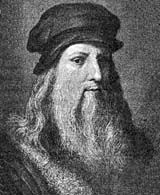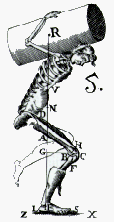 This
artist, engineer, and scientist, da Vinci was particularly interested in
the structure of the human body as it relates to performance, center of
gravity and the balance and center of resistance. He used letter to identify
muscles and nerves in the human body that he retrived from grave yards
in the middle ofthe night. ( ) He described the mechanics of the body during
standing, walking up and downhill, rising from a sitting position, jumping,
and human gait. To demonstrate the progressive action and interaction ofvarious
muscles during movement, he suggested that cords be attached to a skeleton
at the points oforigin and insertion ofthe muscles.
This
artist, engineer, and scientist, da Vinci was particularly interested in
the structure of the human body as it relates to performance, center of
gravity and the balance and center of resistance. He used letter to identify
muscles and nerves in the human body that he retrived from grave yards
in the middle ofthe night. ( ) He described the mechanics of the body during
standing, walking up and downhill, rising from a sitting position, jumping,
and human gait. To demonstrate the progressive action and interaction ofvarious
muscles during movement, he suggested that cords be attached to a skeleton
at the points oforigin and insertion ofthe muscles.
 Galileo
Galilei was a student of medicine before he became famous as a physicist.
He discovered the constancy of the pediod of a pendulum, and used the pendulum
to measure the pulse rate of people, expressing the results quantitatively
in terms of the lenght of a pendulum syncronous to the heart.
Galileo
Galilei was a student of medicine before he became famous as a physicist.
He discovered the constancy of the pediod of a pendulum, and used the pendulum
to measure the pulse rate of people, expressing the results quantitatively
in terms of the lenght of a pendulum syncronous to the heart.
Galielo's fame was so grea and his lectures in Padua so popular that
his influence on biomechanics went far beyond his personal
contribtions. According to Singer (History, p. 237), William Harvey
should be regarded a disciple of Galileo. Harvey studied in
Padua (1598-1601) while Galileo was active there. By 1615 Harvey had
formed the concept of circulation of blood. He published his demonstration
in 1628. The essential part of his demonstration is the result not of mere
observation but of the application of Galieleo's principle of measurement.
He showed first thatthe blood can only leave the ventricle of the heart
in one direction. Then he measured the capacity of the heart, and found
it to be about two ounces. The heart beats 72 times a minute, so that in
one hour it throws into the system 2x72x60 ounces =8640 ounces = 234 kg!
Where can all this blood come from? Where can it all go? He concludes that
the existence of circuation is a necessary condition for the function of
the heart. (p.3)

Borelli estimated the center of mass of nude men by having them stretch out on a rigid platform supported on a knife edge. The platform was then repositioned until is balanced, thereby indicating a location corresponding to the center of mass for the entire body.
On the Motion of Animals (De Motu Animalum) 1680
Commentary on thr Effects of Electricity on Muscular Motion (1791)